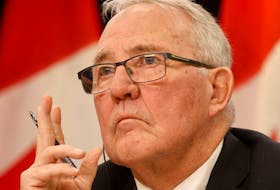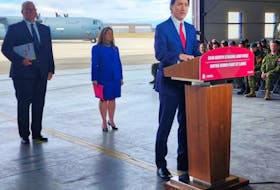There should be no debate about systemic racism in Canada.
The residents of Rosedale in Toronto or Rockcliffe in Ottawa would not tolerate boil water advisories or youth suicide rates seven times higher than the national average – the norm for a number of indigenous communities.
But there have been successes in Canada’s relationship with its First Nations and they need to be nurtured during the current COVID-19 crisis.
A singular achievement has been the First Nations Finance Authority, a native governed institution that raises money from institutional investors in Canada, the U.S. and beyond. It is a success story, but one which is threatened by the scale of the lockdown.
The market has accepted the FNFA as bona fide
The FNFA has a history of prudent lending.
Ernie Daniels, president and CEO, said his organization made its inaugural loan in 2012 and has since raised $940 million on capital markets, creating an estimated 9,000 jobs.
The FNFA boasts that it has had no defaults because of its structure. All of the bands granted loans have some form of revenue source – from property taxes to mineral rights or gaming revenues. The FNFA calculates borrowing capacity based on those activities and then requires the band to sign a “revenue intercept mechanism” that guarantees the community’s revenue stream as repayment for the loan.
To reassure nervous investors, loans are also backed by a debt reserve fund financed by all borrowing members of the pool and a $30 million credit enhancement fund, back-stopped by the federal government.
However, even its frugal practises have struggled to cope with COVID. Daniels appeared before the federal finance committee this week and noted that the “induced coma” of COVID-19 had affected the revenue-raising capacity of all the FNFA’s borrowing members. “The risk management and credit enhancement features of the FNFA did not contemplate as many borrowing members being in financial stress at the same time,” he said.
He recommended that the federal government inject $50 million into an emergency fund that would allow on-going liquidity for borrowing members.
He also suggested that the Bank of Canada buy around $250 million of commercial paper issued by the FNFA to backstop existing needs.
Skeptics should look more closely at the FNFA’s track record.
When Chief Clarence Louie of the Osoyoos Indian Band in British Columbia’s dusty interior was contemplating new office space he didn’t want a typical looking office building. He was looking for something that drew inspiration from the history of the Osoyoos. The striking structure that was eventually constructed featured logs used in traditional reed-covered tee-pees and a gathering space built to look like a plateau-style hat used by the tribes of the interior.
The 540-member band needed new offices because it had outgrown its existing space – the consequence of turning one of the hottest and driest parts of Canada into an economic powerhouse. The rattlesnake infested sagebrush canyons now host an award-winning winery, a golf course, a hotel and motor racetrack designed by former Formula 1 driver, Jacques Villeneuve.
Osoyoos has the financial clout to borrow money from commercial banks. Yet when it was raising funds for the band office, it opted to take a loan from the FNFA.
Skeptics should look more closely at the FNFA’s track record
Chief Louie said many banks won’t lend to First Nations that don’t have the revenue-raising ability of richer bands like Osoyoos because in an Indigenous world where property is held communally they are often unable to offer collateral.
The FNFA was set up to address that problem.
It is rated by major credit agencies such as Moody’s, which upgraded it to Aa3 investment grade rating three weeks ago.
“In terms of reception, we have seen a significant uptick in interest by the market since the FNFA’s first bond offering, when it was not a known entity,” said Adam Hardi, assistant vice-president at Moody’s in Toronto.
Steven Fleckenstein, managing director of fixed income at National Bank of Canada, which has acted as dealer for the FNFA, said the initial wary response to bonds issued by an indigenous organization was reflected in the yield – 37 basis points over the rate offered by the bellwether issuer, the province of Ontario. But as comfort levels have evolved, that spread narrowed to 16 basis points in a more recent issue, which was doubly oversubscribed.
“It’s quite a success story,” said Fleckenstein. “The market has accepted the FNFA as bona fide.”
The appetite in capital markets has been stimulated by the desire for ethical environmental and social investments – 30 per cent of projects funded by FNFA loans are in renewable energy; 60 per cent are in social infrastructure like schools and health centres.
Ryan Goulding, a fund manager at portfolio manager Leith Wheeler, has invested in every FNFA issue and his firm is now its largest investor. “I love the credit and it has performed very well for us,” he said. “What attracted us in the first place is the structure of this debt. I can’t think of another issue where the credit profile gets better the more debt that is issued. As more First Nations become members, it spreads out the liability and diversifies the revenue streams.”
While there is a demand for the debt, it is limited by the revenue-raising capacity of First Nations.
There are two solutions to this – leverage the government’s annual funding allocation for First Nations on capital markets; or, transfer more revenue-raising capacity to First Nations.
In the longer term, Daniels told the finance committee this week that the FNFA could facilitate an alternate financing scheme to build community infrastructure on reserves. He proposed a monetization program that would raise funds to help finance infrastructure programs at today’s prices, rather than the pay-as-you-go model the government currently employs.
Daniels said that the FNFA has identified shovel-ready infrastructure projects on 28 First Nations, with a value of $541-million, that would be suited for such a monetization policy.
We have seen a significant uptick in interest by the market
The infrastructure gap on Canadian reserves has been estimated at $35 billion, leaving many with boil water advisories, power from diesel generators and poor housing stock. Indigenous Canadians are just 4.3 per cent of the population but their numbers are growing at four times the rate of non-indigenous citizens.
The second way to utilize the FNFA model to greater effect would be to increase the revenue-raising capacity on reserves.
The criticism levelled against the FNFA is that it favours communities that are already doing well.
However, Daniels said that the FNFA and its sister organization, the First Nations Tax Commission, are working with the federal government to use the same model with less well-off bands that could see borrowing capacity grow ten-fold.
The deal being proposed is that Ottawa would transfer excise tax being raised on reserves through the sale of petrol, tobacco, alcohol and cannabis.
Justin Trudeau’s government has made reconciliation with indigenous Canadians one of its top priorities and has signed a memorandum of understanding with the Assembly of First Nations to work towards “sufficient, predictable and sustained funding” for the country’s native population.
The scrutiny is above and beyond anything you’d get from federal politicians
Finance Minister Bill Morneau and his most senior bureaucrats are said to be keen to roll out FNFA funding because they believe it works.
Kevin Page, the former parliamentary budget officer and now head of a public policy think-tank at the University of Ottawa, sits on the committee struck by the government to come up with a new fiscal relationship with First Nations. He said the idea of allowing First Nations to keep excise tax revenues raised on their territory has merit. “I personally think it is in keeping with a vision that gives First Nations more autonomy and resources for development of badly needed infrastructure,” he said.
There is a strong argument that the FNFA offers a more measured approach to infrastructure development than direct federal government investment, since every project needs unanimous approval from a board made up of borrowing members.
“They are joint and severally liable, so the scrutiny is above and beyond anything you’d get from federal politicians,” said Leith Wheeler’s Goulding.
Manny Jules, chief commissioner of the First Nations Tax Commission, said the pitch to the federal government is “the more responsibility we have to look after ourselves, the less responsibility you have”.
There is a blossoming courtship between Canada’s Indigenous communities and capital markets but the matchmaker sustaining that relationship has been sideswiped. Ottawa should lend a hand.
• Email: [email protected] | Twitter: IvisonJ
Copyright Postmedia Network Inc., 2020








